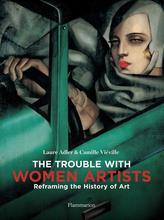More about Georgia O'Keeffe
- All
- Info
- Video
- Shop
Works by Georgia O'Keeffe

Contributor
Everybody knows Georgia O'keeffe for paintings of flowers that resemble… “lady parts.”
O’Keeffe is one America’s most famous female artists, and during her career, she was one of the best paid. But she may not have shot to the top as powerfully or quickly without the help of friends in high places--namely, her lover Alfred Stieglitz.
Stieglitz was a (married) hotshot photographer 24 years O’Keeffe’s senior when they met in 1915. A mutual friend showed Stieglitz some of O’Keeffe’s charcoal drawings, and he insisted on showing her work at his notable New York gallery 291, even though she was a 28-year-old schoolteacher living in Texas. A long distance letter correspondence grew into mentorship and then something steamier, until finally O’Keeffe moved to New York, Stieglitz’s wife walked in on him photographing O’Keeffe in the nude, and the two were married not long after.
Life with Stieglitz must have been no cake walk. He was reputed to be a manipulative sonuvabitch, and derived great satisfaction from controlling O’Keeffe’s career and commercial success. They both enjoyed plenty of infidelities--O’Keeffe was particularly keen on the ladies, as you might guess, and is even rumored to have been lovers with artist Agnes Martin.
But O’Keeffe’s greatest lover of all must have been New Mexico. After taking a vacation there without Stieglitz, she became so inspired by the rugged landscape that she decided to stay. There she enjoyed creative solitude while Stieglitz carried on a very public affair with Dorothy Nauman, a 21-year-old married woman in the New York art world. Whether for reasons of love or economy, O’Keeffe and Stieglitz miraculously stayed together until Stieglitz died in 1946.
As her own end drew nigh, O’Keeffe endured what most artists might consider their worst nightmare--loss of sight. Going blind, however, didn’t stop her from rendering the beauty of the weathered New Mexico landscape. A staff of assistants were able to help her create her visions, both remembered and imagined, in her last years.
You can get to know O’Keeffe quite intimately through many, many photographs that Stieglitz took of her (plenty of them nude). O’Keeffe was regarded by many notable photographers to be something of a muse, and artists like Ansel Adams, Arnold Newman, Irving Penn and Andy Warhol have photographed her at various ages and stages of her life.
Featured Content
Here is what Wikipedia says about Georgia O'Keeffe
Georgia Totto O'Keeffe (November 15, 1887 – March 6, 1986) was an American modernist painter and draftswoman whose career spanned seven decades and whose work remained largely independent of major art movements. Called the "Mother of American modernism", O'Keeffe gained international recognition for her paintings of natural forms, particularly flowers and desert-inspired landscapes, which were often drawn from and related to places and environments in which she lived.
From 1905, when O'Keeffe began her studies at the School of the Art Institute of Chicago, until about 1920, she studied art or earned money as a commercial illustrator or a teacher to pay for further education. Influenced by Arthur Wesley Dow, O'Keeffe began to develop her unique style beginning with her watercolors from her studies at the University of Virginia and more dramatically in the charcoal drawings that she produced in 1915 that led to total abstraction. Alfred Stieglitz, an art dealer and photographer, held an exhibit of her works in 1917. Over the next couple of years, she taught and continued her studies at the Teachers College, Columbia University.
She moved to New York in 1918 at Stieglitz's request and began working seriously as an artist. They developed a professional and personal relationship that led to their marriage on December 11, 1924. O'Keeffe created many forms of abstract art, including close-ups of flowers, such as the Red Canna paintings, that many found to represent vulvas, though O'Keeffe consistently denied that intention. The imputation of the depiction of women's sexuality was also fueled by explicit and sensuous photographs of O'Keeffe that Stieglitz had taken and exhibited.
O'Keeffe and Stieglitz lived together in New York until 1929, when O'Keeffe began spending part of the year in the Southwest, which served as inspiration for her paintings of New Mexico landscapes and images of animal skulls, such as Cow's Skull: Red, White, and Blue (1931) and Summer Days (1936). After Stieglitz's death in 1946, she lived in New Mexico for the next 40 years at her home and studio or Ghost Ranch summer home in Abiquiú, and in the last years of her life, in Santa Fe. In 2014, O'Keeffe's 1932 painting Jimson Weed/White Flower No. 1 sold for $44,405,000—at the time, by far the largest price paid for any painting by a female artist. Her works are in the collections of several museums, and following her death, the Georgia O'Keeffe Museum was established in Santa Fe.
Check out the full Wikipedia article about Georgia O'Keeffe


































I don't get it. Why does everyone fall all over themselves for Georgia O Keefe? No beheadings, no bible scenes, no crazy colors, no monkeys, no battles, no portraits of celebrities. Just boring illustrations devoid of any dynamism and flowers that look like vaginas. Ok, I'll concede those hold some appeal. One star.